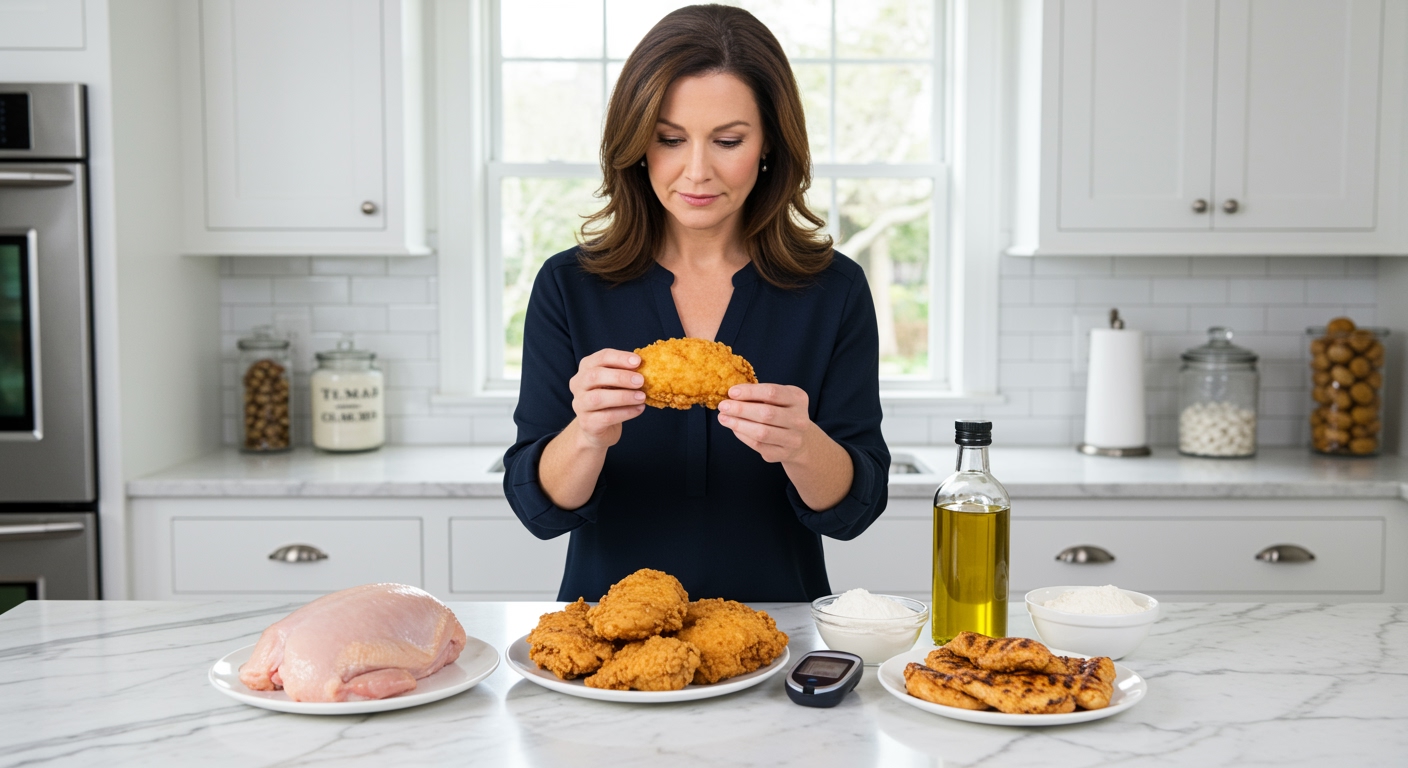✪ Key Takeaway: Fried chicken can spike blood sugar due to breading and oils, but skinless grilled chicken remains diabetes-friendly.
Introduction
You smell that crispy, golden fried chicken and your mouth starts watering, but then reality hits.
You might be wondering if this comfort food will send your blood sugar through the roof or if there is a way to enjoy it safely with diabetes.
Hi, I am Abdur, your nutrition coach and today I am going to explain exactly how fried chicken affects your blood sugar and what you need to know to make smart choices.
How Does Fried Chicken Affect Blood Sugar?
Fried chicken creates a double problem for your blood sugar control.
The breading contains refined flour and sometimes added sugars that get absorbed quickly into your bloodstream.
This coating typically adds 15-20 grams of carbohydrates per piece, which can cause blood sugar spikes within 30-60 minutes after eating.
The frying process makes things worse by creating advanced glycation end products that can increase insulin resistance over time.
These harmful compounds form when proteins and sugars react under high heat, making it harder for your body to process glucose effectively.
The chicken meat itself has zero carbohydrates and would not raise blood sugar, but the preparation method changes everything.
✪ Fact: Plain chicken breast has a glycemic index of zero, but breaded fried chicken can reach 45-55 on the glycemic scale.
What Makes Restaurant Fried Chicken Worse?
Restaurant fried chicken poses additional risks that homemade versions might avoid.
Most restaurants use trans fats or partially hydrogenated oils that increase inflammation and worsen insulin sensitivity.
These oils get reused multiple times, creating more toxic compounds that your body struggles to process.
The portion sizes at restaurants are typically much larger than what you would make at home.
A typical restaurant serving contains 2-3 pieces with heavy breading, delivering 40-60 grams of carbohydrates in one meal.
Many chains also add sugar to their breading mixture and marinades to enhance flavor and create that golden color.
This hidden sugar content can catch you off guard and cause unexpected blood sugar spikes even if you account for the obvious carbohydrates.
✪ Pro Tip: Always remove the skin and breading before eating restaurant fried chicken to reduce carbohydrate impact by 70-80%.
Can You Make Diabetes-Friendly Fried Chicken?
You can create better alternatives that satisfy your fried chicken cravings without destroying your blood sugar.
Use almond flour or crushed pork rinds instead of regular flour for breading to cut carbohydrates by 80-90%.
These alternatives provide the crispy texture you want while keeping total carbs under 3-5 grams per serving.
Air frying or oven baking with a light coating creates similar results without the harmful oils.
This method reduces the formation of those dangerous compounds while still giving you crispy, flavorful chicken.
Season with herbs and spices instead of sugary marinades to add flavor without extra carbohydrates.
Paprika, garlic powder, onion powder, and cayenne pepper create delicious flavor profiles that make you forget about traditional breading.
✪ Note: Skinless chicken thighs work better than breasts for air frying because they stay moist and flavorful without breading.
What About Eating Fried Chicken Occasionally?
Occasional consumption might be manageable if you plan carefully and make smart adjustments.
Remove all visible breading and skin before eating to eliminate most of the problematic carbohydrates.
This simple step can reduce the carb content from 40-50 grams down to 5-10 grams per serving.
Pair it with high-fiber vegetables like broccoli or green beans to slow down glucose absorption.
The fiber creates a barrier in your digestive system that prevents rapid spikes in blood sugar levels.
Take a short walk after eating to help your muscles use up some of the glucose before it accumulates in your bloodstream.
Even 10-15 minutes of light activity can make a significant difference in your post-meal blood sugar response.
✪ Pro Tip: Check your blood sugar 2 hours after eating fried chicken to understand your personal response and adjust future portions.
The Bottom Line
Traditional fried chicken is not a good choice for diabetes management because the breading and frying process create blood sugar spikes and long-term complications.
Smart food choices today create the foundation for better health tomorrow, and this applies especially to how you prepare your favorite foods.
I would love to hear about your experiences with fried chicken alternatives or any questions you have about making diabetes-friendly versions of your favorite comfort foods in the comments below.
References
At NutritionCrown, we use quality and credible sources to ensure our content is accurate and trustworthy. Below are the sources referenced in creating this article:
- Harvard T.H. Chan School of Public Health: Eating fried foods tied to increased risk of diabetes and heart disease
- PMC: Advanced glycation end products in foods and a practical guide to their reduction in the diet
- Glycemic Index Net: Chicken Fried Glycemic Index
- Food Struct: Chicken meat glycemic index





